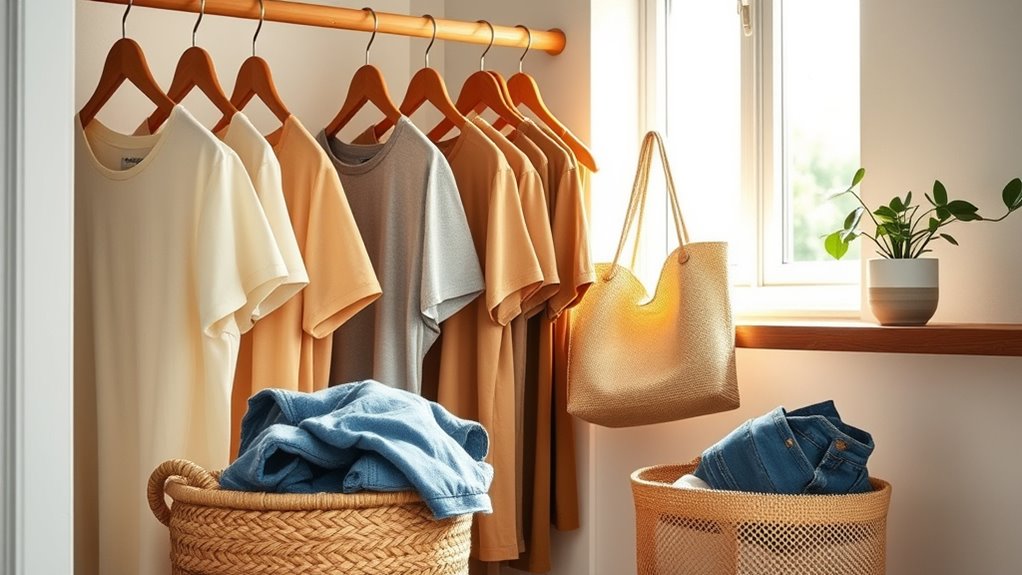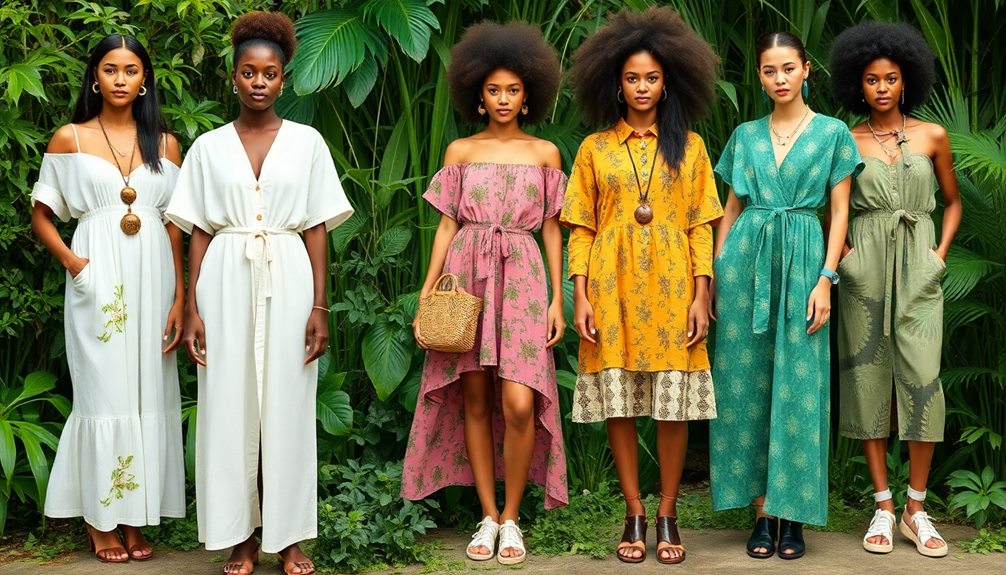To build an eco-friendly wardrobe, focus on choosing high-quality, durable pieces made from sustainable materials like organic cotton or recycled fabrics. Support transparent brands that prioritize fair labor practices and ethical sourcing. Care for your clothes properly to extend their lifespan, and consider shopping secondhand or upcycling to reduce waste. Building a capsule wardrobe with timeless items helps you stay stylish while minimizing environmental impact—stay tuned to learn more about creating your sustainable fashion journey.
Key Takeaways
- Choose timeless, versatile pieces made from eco-friendly materials to reduce the need for frequent replacements.
- Support brands with transparent sourcing, fair labor practices, and certifications like Fair Trade or GOTS.
- Invest in durable garments and follow proper care routines to extend clothing lifespan and minimize waste.
- Build a capsule wardrobe with high-quality, sustainable essentials to promote a minimalist, environmentally conscious closet.
- Shop secondhand and consider upcycling to reduce textile waste and add unique character to your wardrobe.
Understanding the Principles of Sustainable Fashion
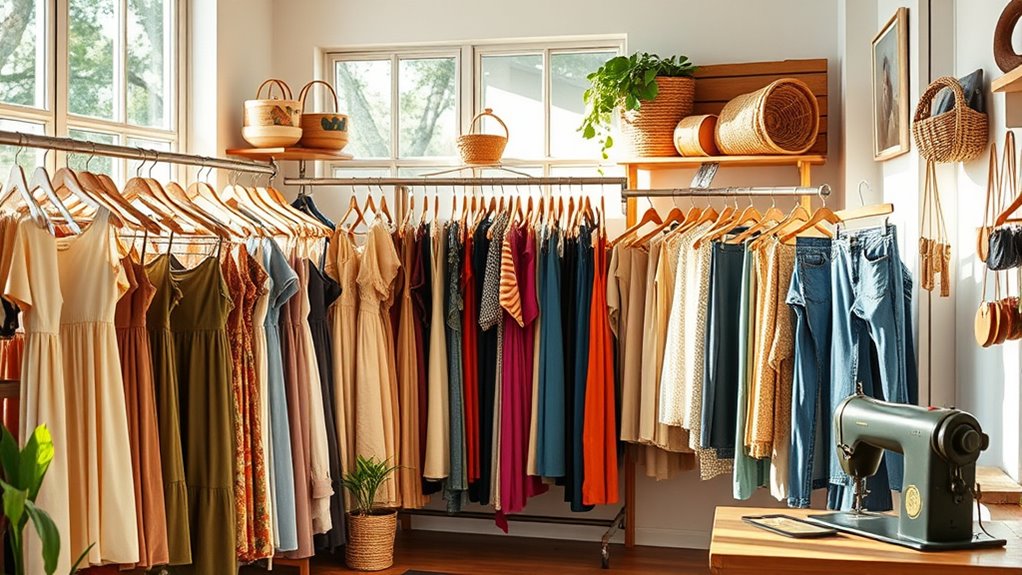
Understanding the principles of sustainable fashion is essential if you want to make more environmentally and ethically responsible choices. It involves recognizing how clothing production impacts the planet, such as water use, pollution, and waste. Sustainable fashion emphasizes using eco-friendly materials like organic cotton or recycled fabrics, which reduce environmental harm. It also promotes fair labor practices, ensuring workers are paid fairly and work in safe conditions. Transparency is key—you should seek brands that openly share their sourcing and manufacturing processes. Additionally, sustainability encourages mindful consumption, urging you to buy only what you need and prioritize quality over quantity. Incorporating sustainable materials such as organic cotton and recycled fabrics can significantly lessen ecological impact. Choosing well-made, supportive clothing not only enhances comfort but also supports a more sustainable wardrobe. To further reduce your ecological footprint, consider ethical manufacturing practices that ensure minimal environmental impact throughout the supply chain. Being aware of environmental impact factors involved in clothing production can help you make more informed decisions. Understanding the importance of air filtration technology can guide you toward selecting high-quality, durable products that last longer and reduce waste. By understanding these principles, you can make informed decisions that support a more sustainable fashion industry and minimize your ecological footprint.
Choosing Quality Over Quantity

When you choose clothing made from durable materials, you invest in pieces that last longer and reduce waste. Opting for timeless styles means you’ll wear your wardrobe staples for years, not seasons. Prioritizing quality over quantity helps you build a sustainable closet that’s both eco-friendly and stylish. Additionally, selecting furniture with natural materials like wood can further support sustainable fashion principles in your lifestyle. Incorporating ethical sourcing practices ensures that your clothing choices positively impact the environment and communities involved. Understanding the role of sound vibrations in promoting cellular regeneration can inspire more mindful and holistic approaches to sustainable living. Being aware of drivetrain components and their maintenance can also prolong the lifespan of your cycling gear, reducing the need for frequent replacements. Practicing mindful consumption and choosing brands committed to sustainable manufacturing can further enhance your eco-friendly wardrobe.
Durable Materials Matter
Choosing durable materials is essential because investing in quality pieces often means they’ll last longer and look better over time. When you select fabrics like organic cotton, hemp, or recycled fibers, you’re making a conscious choice to reduce waste and avoid fast fashion. These materials withstand regular wear and washing, maintaining their shape and color longer. Durable fabrics also tend to develop a unique character as they age, adding to their appeal. By prioritizing high-quality materials, you prevent the cycle of frequent replacements that contribute to environmental harm. Remember, your goal is to build a wardrobe that’s not only stylish but sustainable. Choosing resilient fabrics ensures your clothing remains functional and attractive, helping you make smarter, eco-friendly choices every day.
Timeless Style Selection
Choosing quality over quantity guarantees your wardrobe remains both stylish and sustainable. Instead of chasing fleeting trends, focus on timeless pieces that never go out of style. Invest in well-made items crafted from durable, eco-friendly materials—think organic cotton, linen, or recycled fabrics. These pieces may cost more upfront, but they last longer and maintain their appearance over time. By selecting versatile, classic styles, you reduce the need for frequent replacements, lowering your environmental impact. Prioritize fit and craftsmanship to ensure each item complements your personal style and holds up through years of wear. Additionally, opting for high-quality materials ensures your clothing remains durable and eco-friendly, supporting sustainable fashion choices. This approach not only helps you build a more sustainable wardrobe but also cultivates a refined, authentic look that stands the test of time.
Supporting Ethical and Transparent Brands
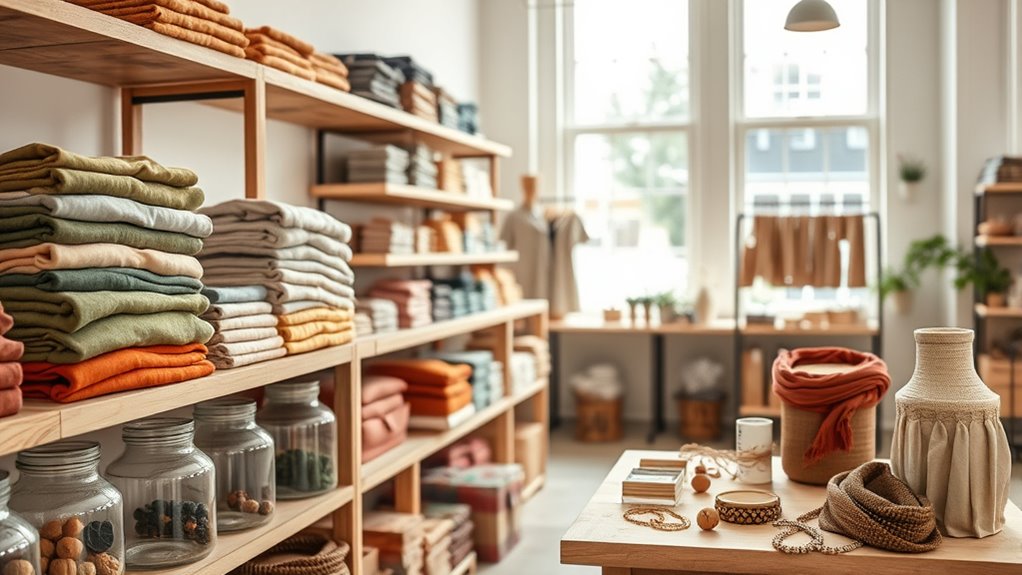
You can make a difference by choosing brands that are open about their sourcing and manufacturing processes. Check for transparency reports and certifications to verify their integrity. Prioritizing brands that ensure fair labor practices helps support ethical fashion from the ground up. Additionally, supporting brands that prioritize transparency and disclose their supply chain details fosters greater accountability in the industry. Incorporating sustainable materials into your wardrobe choices further promotes environmentally friendly practices and reduces ecological impact. Using eco-friendly fabrics can significantly lessen your fashion footprint and encourage industry-wide change.
Verifying Brand Transparency
How can you confidently identify brands that prioritize transparency and ethical practices? Start by researching their communication—look for clear, detailed info about sourcing, manufacturing, and sustainability goals. Check if they openly share audits or certifications, like Fair Trade or GOTS. You can also:
- Visit their website for sustainability reports and supply chain details
- Follow their social media for behind-the-scenes insights
- Read reviews from other consumers focused on transparency
- Look for third-party certifications verifying ethical practices
- Consider their commitment to transparency, including how openly they communicate about their practices, and pay attention to their efforts to provide traceability information so consumers can verify the origins of their products. Additionally, examining their water usage and conservation efforts can provide further insight into their environmental impact. Recognizing a brand’s ethical commitments can help ensure your wardrobe choices support sustainable practices. Moreover, evaluating their environmental impact assessments can offer a comprehensive view of their sustainability efforts.
Prioritizing Fair Labor
Ever wondered how to guarantee the brands you support treat their workers fairly? Start by researching their supply chains and labor practices. Look for certifications like Fair Trade, SA8000, or B Corp, which indicate ethical standards. Support brands that are transparent about their factories, wages, and working conditions. Avoid companies that refuse to disclose information or have a history of labor violations. Prioritizing fair labor means choosing brands committed to safe environments, reasonable hours, and fair pay. Your purchasing decisions can drive change by rewarding companies that uphold workers’ rights. Remember, ethical fashion isn’t just about the final product—it’s about respecting everyone involved in the process. Fostering dynamic communication exercises between brands and consumers can further promote accountability and transparency. Incorporating ethical labor practices into your brand choices encourages businesses to improve their standards. Supporting brands that prioritize labor rights can lead to meaningful improvements across the industry. Engaging in transparency initiatives can also help hold brands accountable and promote industry-wide change. Building awareness about supply chain transparency empowers consumers to make more informed choices and advocate for better standards industry-wide. By supporting ethical and transparent brands, you help create a more just and sustainable fashion industry.
Caring for and Extending the Life of Your Clothes
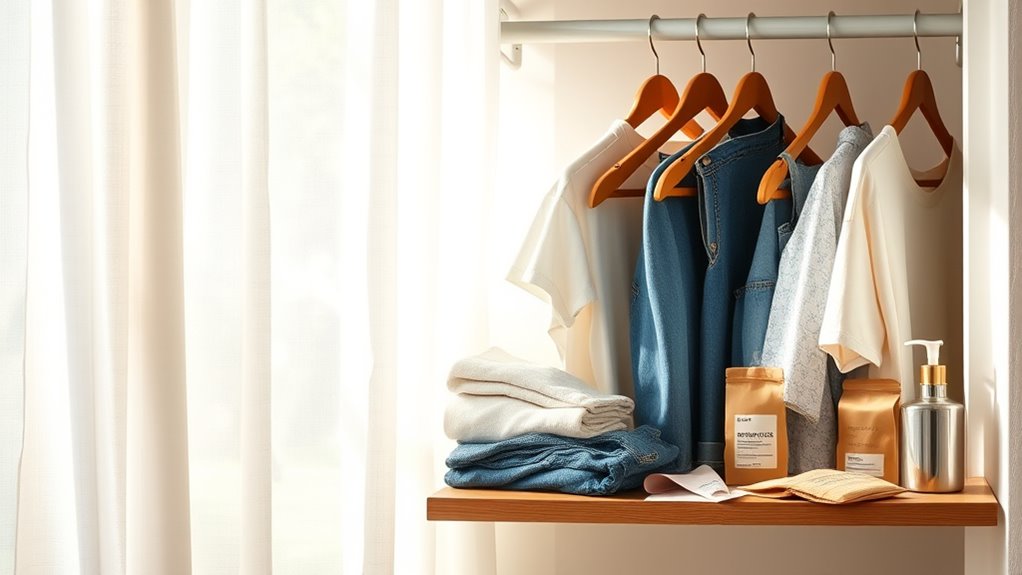
Taking proper care of your clothes not only keeps them looking their best but also extends their lifespan, making your wardrobe more sustainable. To do this, wash clothes in cold water whenever possible, which saves energy and prevents fading. Always follow the care labels to avoid damage. Use gentle detergents that are eco-friendly and skip the dryer—air drying reduces wear and saves energy. Handle delicate fabrics with care, and mend small tears or loose buttons promptly to prevent bigger issues. Essential oils can be used in laundry to naturally freshen clothes and add antimicrobial benefits. Here are some tips to help you care for your wardrobe:
Proper clothing care extends wardrobe life and promotes sustainability through gentle washing and mindful handling.
- Wash clothes inside out to preserve color and fabric
- Use mesh bags for delicate items during laundry
- Store clothes properly, folded or hung, to prevent stretching
- Rotate your wardrobe to reduce wear on favorite pieces
- Proper clothing maintenance can further extend the life of your garments and promote sustainable fashion practices.
These simple steps keep your clothes looking good and last longer.
Incorporating Secondhand and Upcycled Pieces
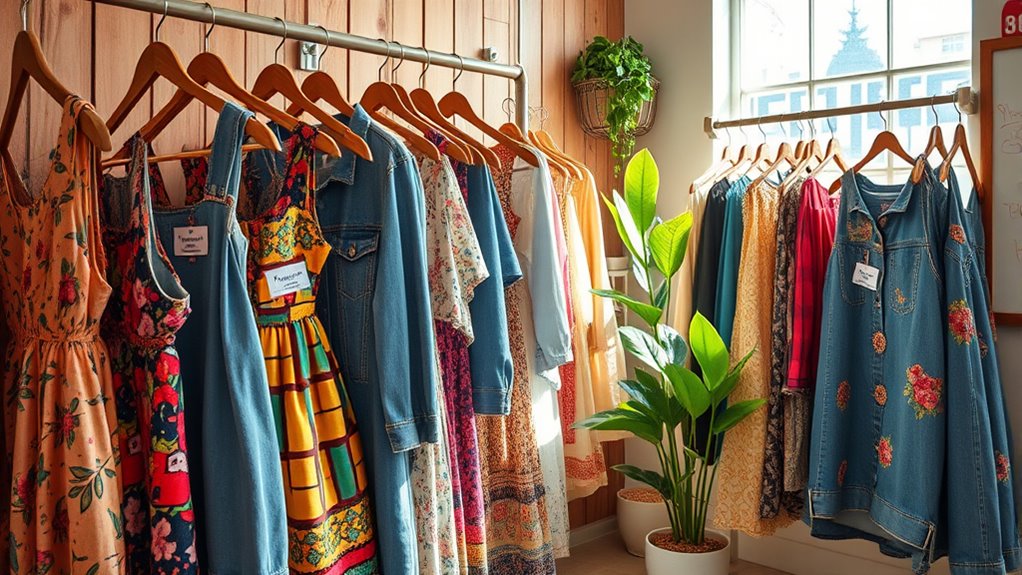
Incorporating secondhand and upcycled pieces into your wardrobe is a simple yet impactful way to reduce waste and promote sustainability. Shopping secondhand allows you to find unique, quality items without supporting fast fashion’s environmental costs. Thrift stores, online marketplaces, and vintage shops make it easy to discover affordable, stylish pieces that breathe new life into your wardrobe. Upcycling takes this a step further by transforming existing garments into something fresh and personalized. You can DIY projects or collaborate with local artisans to create one-of-a-kind items. Not only does this reduce textile waste, but it also decreases demand for new clothing production. By choosing secondhand and upcycled pieces, you make eco-conscious choices that benefit the planet while adding character and diversity to your style.
Building a Capsule Wardrobe for Longevity
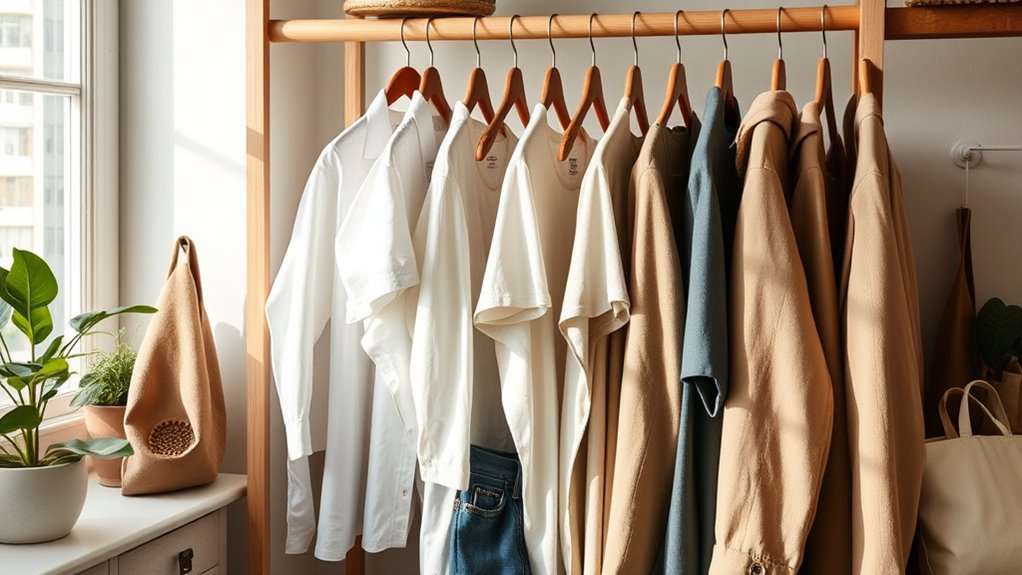
Creating a capsule wardrobe is a practical way to build a sustainable, versatile closet that lasts over time. Focus on quality pieces that can mix and match easily, reducing the need for excess clothing. Choose timeless styles and neutral colors to keep your wardrobe adaptable. Prioritize durability and comfort, investing in garments made from eco-friendly fabrics. Regularly assess your collection to remove items you no longer wear, keeping your wardrobe streamlined.
Here are some tips:
- Invest in classic staples like a white shirt or well-fitted jeans
- Opt for high-quality fabrics like organic cotton or linen
- Limit your color palette for easier pairing
- Repair or alter clothes to extend their lifespan
This approach guarantees your wardrobe remains functional, stylish, and sustainable over time.
Frequently Asked Questions
How Can I Identify Truly Eco-Friendly Clothing Brands?
To spot truly eco-friendly clothing brands, you should look for transparency and certifications like GOTS or Fair Trade. Check their website for details on sustainable materials and ethical practices. Research their supply chains and labor policies. Avoid brands that overpromise or lack clear information. Supporting local or small businesses often guarantees better sustainability. By staying informed and asking questions, you can make smarter, eco-conscious choices when shopping.
What Are the Best Fabrics for Sustainable Fashion?
When choosing fabrics for sustainable fashion, you should look for natural, biodegradable options like organic cotton, hemp, and linen. These materials use fewer chemicals and less water during production. Recycled fabrics such as recycled polyester or nylon also help reduce waste. Avoid synthetic fibers like conventional polyester, which shed microplastics. By selecting these eco-friendly fabrics, you support a more sustainable wardrobe and reduce your environmental impact.
How Do I Reduce Fast Fashion Consumption Effectively?
Imagine you’re a knight in shining armor, fighting against fast fashion. To reduce your consumption, set a budget and prioritize quality over quantity. Research brands committed to sustainability, and buy less but better pieces. Repair and upcycle your clothes instead of discarding them. Avoid impulse buys by making thoughtful choices, and embrace timeless styles. This way, you’ll build a wardrobe that’s eco-friendly, durable, and truly reflects your personal style.
Are There Affordable Options for Sustainable Wardrobe Building?
You’re wondering if affordable options exist for building a sustainable wardrobe. The good news is, yes, they do! You can start by shopping at thrift stores, swapping clothes with friends, or exploring brands that prioritize eco-friendly materials and fair labor at lower prices. Focus on buying quality over quantity, and consider investing in versatile pieces you’ll wear often. Small, mindful choices can make sustainable fashion both accessible and budget-friendly.
How Can I Recycle or Donate Old Clothes Responsibly?
Imagine your closet as a treasure chest overflowing with forgotten relics. You can recycle or donate responsibly by sorting clothes into keep, donate, or recycle piles. Find local charities, thrift stores, or textile recycling programs that accept gently used garments. Before donating, verify clothes are clean and in good condition. Think of it as giving your old clothes a second life, sparing landfills and helping someone in need.
Conclusion
Imagine your wardrobe as a garden—you tend it carefully, nurture it, and it blooms beautifully over time. By choosing sustainable fashion, you’re planting seeds for a healthier planet and a more stylish future. Remember, every mindful purchase is like watering a sapling; it grows into something lasting. With small, consistent steps, you can create an eco-friendly wardrobe that not only looks good but also feels good to support.
